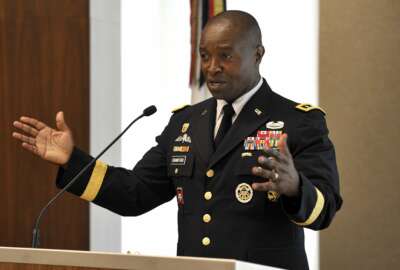 Exclusive
Exclusive Army’s forthcoming data strategy comes with new standards, ‘ruthless’ enforcement
The ink is dry on the Army's new data strategy. Once it's officially released, it will come with specific orders telling Army components to adhere to common data...
The Army is days away from releasing an updated strategy to help wrangle its vast data holdings into a more interoperable whole. And the latest version will come with teeth.
The new data strategy will embrace all five of the principles officials outlined when they released the previous version three years ago. Across the service data, should be:
- Visible
- Accessible
- Understandable
- Trusted and
- Interoperable.
On top of all that, according to the forthcoming edition, it should also be secure.
Lt. Gen. Bruce Crawford, who has served as the Army’s chief information officer for the past two years, said the fundamentals the service put in place in 2016 were sound, but that it’s time to back them up with mechanisms that will prompt Army system owners to embrace the strategy. So this time around, it will also include at least some specific standards that data systems will be required to adhere to.
“What we never did, institutionally, was take the next step to actually implement the strategy,” he said Monday in an interview with Federal News Network. “So what does implementation look like? It’s telling the Army to do it, describing the outcomes that you’re looking for, articulating the metrics so that you can measure it over time, and resourcing it. So the implementation plan is where we’re focusing our attention now.”
Crawford said the document is fully drafted and is awaiting the approval of the rest of the Army’s senior leadership before it’s formally released. Once it is, it’s expected to be accompanied by an execute order from the deputy chief of staff for operations which instructs the Army on specific steps to put the strategy into place.
Related Stories
“You can think of them as a pie divided into four pieces, and the data strategy will be right in the middle,” Crawford said. “It’s going to be the forcing function that says, ‘Inside your mission area, you’re going to have data governance. But here are some minimum standards you must meet to make sure that your data is visible, that it’s interoperable, usable, accessible, et cetera.’ We want to make sure we don’t over-enforce to the point that we suboptimize the overall effort, but we’ve identified the standards, and we’re going to have to be ruthless in enforcing the standards.”
Crawford said he has told the Army’s senior leadership that implementing the new strategy will be among the most difficult management challenges the service will face over the next ten years, and that even the most rigorous implementation will not eliminate the disparities and seams between Army networks overnight. However, he expects to enforce the new standards both to new data systems and to existing ones.
“We’ve learned the hard way what happens when you bypass [older systems] and you don’t go back and sweep up, because that’s where some of our more critical data elements reside,” he told an Association of the U.S. Army conference earlier in the day. “So there’s a look back at the current, and it’s going to take some resources to do that. But there’s a stake in the ground that says ‘henceforth and forever more, here’s how we’re going to do business.’”
However, Crawford said the forthcoming document was built with extensive consultation with the operators and acquirers of the Army’s existing data systems, so it’s unlikely they’ll be caught off-guard by its contents. Many of those officials had already been rationalizing and restricting their data stores in order to get them ready for the artificial intelligence applications the Army and DoD want to start applying to those datasets.
Similarly, he said his office had already shopped the strategy around to some of the program management offices in charge of building some of the Army’s largest data systems, including the Integrated Pay and Personnel System-Army (IPPS-A).
“We took the strategy to the IPPS-A team, and I said, ‘I want them to mark this up.’ We did the same thing with the Army Leader Dashboard team,” Crawford said. “There has to be connective tissue between our plan and the actual standards that we’re looking to implement, but the second piece is there are other live efforts that have been ongoing in the Army for about the last 18 months. We’re trying to take advantage of those efforts, because they’ve done it. For example, the logistics community is one of our biggest data users, and it’s eye-watering how successful they’ve been with divesting non-authoritative data sources in that particular piece of the mission.”
Copyright © 2024 Federal News Network. All rights reserved. This website is not intended for users located within the European Economic Area.
Jared Serbu is deputy editor of Federal News Network and reports on the Defense Department’s contracting, legislative, workforce and IT issues.
Follow @jserbuWFED






